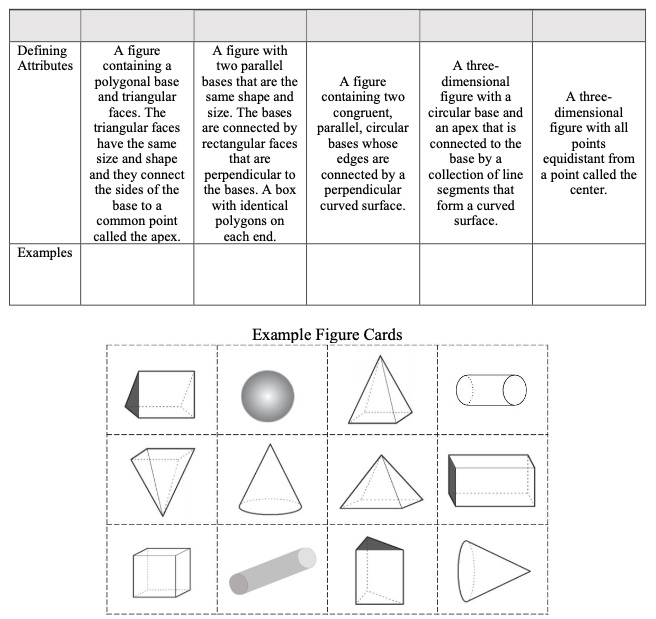General Information
Benchmark Instructional Guide
Connecting Benchmarks/Horizontal Alignment
- There are no direct connections outside of this standard; however, teachers are encouraged to find possible indirect connections.
Terms from the K-12 Glossary
- Cone
- Cylinders
- Edge
- Prisms
- Pyramids
- Sphere
- Vertex
Vertical Alignment
Previous Benchmarks
Next Benchmarks
Purpose and Instructional Strategies
The purpose of this benchmark is to begin formal categorization of three-dimensional figures based on attributes of their faces, edges and vertices. Three-dimensional figures were identified informally in Kindergarten and grade 1. The work in grade 5 prepares students for more detailed work with three-dimensional figures, including finding volumes and surface areas using formulas and nets in grade 6 (MA.6.GR.2.4).- Instruction includes having students use language they have already learned and apply it to a larger variety of figures including prisms and pyramids with any number of sides.
- Instruction includes explaining that a cone has one flat base, a cylinder has two flat bases and a sphere does not have any flat bases, but each of these figures has a curved surface.
Common Misconceptions or Errors
- Students may believe that the orientation of a figure changes the three-dimensional shape.
Strategies to Support Tiered Instruction
- Instruction includes teacher providing a graphic organizer that contains three-dimensional figure names and definitions from the glossary. Students match images of the figures in different orientations to their definitions.
- For example, the teacher provides students with a graphic organizer like the one shown below and a set of three-dimensional figure picture cards. Students match the image to the defining attributes listed.

- Instruction includes providing three-dimensional figures made of plastic or wood and having students identify the shapes that make up their base or bases and faces. Students then look at the definition for each figure and classify it based on the attributes they identified.
- For example, the teacher provides the students with a triangular prism like the one shown below. The students then identify the two bases as triangles and the faces connecting them as rectangles. The teacher provides students with the definitions for three-dimensional figures and has them determine which classification it fits in.

Instructional Tasks
Instructional Task 1 (MTR.4.1)
Categorize the three-dimensional figures below into the table.
- Right pyramids
- Spheres
- Right circular cylinders
- Right prisms
- Right circular cones
Instructional Items
Instructional Item 1
Select all the shapes that contain an apex.- a. Right pyramids
- b. Spheres
- c. Right circular cylinders
- d. Right prisms
- e. Right circular cones May contain a rectangular face Contains no faces
*The strategies, tasks and items included in the B1G-M are examples and should not be considered comprehensive.
